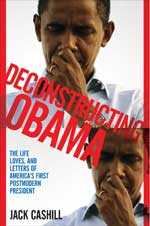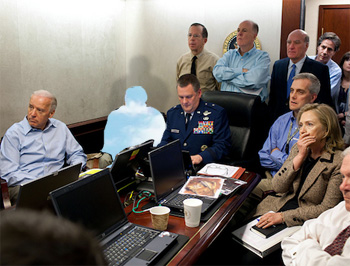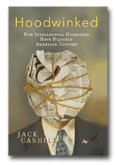What Obama Did on September 11, 2012
Get your copy of Deconstructing Obama

___
Jack Cashill's book:
Hoodwinked: How Intellectual Hucksters have Hijacked American Culture
© Jack Cashill
AmericanThinker.com - May 5, 2014
Fox News - May 5, 2014
Newsmax - may 8, 2014
 Last week, former National Security Council spokesman Tommy Vietor admitted to Fox News’s Bret Baer that President Barack Obama was not in the White House situation room on the night of September 11, 2012. That was the night--"Dude, this was like two years ago”—in which Islamic terrorists killed Ambassador Chris Stevens and three other Americans in Benghazi.
Last week, former National Security Council spokesman Tommy Vietor admitted to Fox News’s Bret Baer that President Barack Obama was not in the White House situation room on the night of September 11, 2012. That was the night--"Dude, this was like two years ago”—in which Islamic terrorists killed Ambassador Chris Stevens and three other Americans in Benghazi.
This admission was a long time coming, in part because mainstream media reporters refrained from asking. In fact, it was not until May 19, 2013, eight months after the attack, that a newsman asked a White House spokesman what Obama did that night. The newsman was Chris Wallace of Fox News. “The ambassador goes missing, ends up the first ambassador in more than thirty years is killed. Four Americans, including the ambassador, are killed. Dozens of Americans are in jeopardy,” asked Wallace of Dan Pfeiffer, a senior adviser to the president. “Where was he? What did he do? How did he respond?” The crafty Pfeiffer would not even acknowledge whether Obama was in the situation room.
As Wallace knew, Obama and his advisers planned military strategy in the situation room. They planned political strategy upstairs in the family quarters. If Pfeiffer was savvy enough to duck that question, Vietor apparently was not. His answer confirms my own suspicions about where Obama was and what he did that evening. As the evidence attests, Secretary of State Hillary Clinton played a critical role in this dumb show.
Even had that day not been September 11, there would have been cause for alarm in Washington. The threat to the American consulate in Benghazi had been obvious since at least 6 a.m. Washington time. It was noon in Libya when Sean Smith, the IT professional who accompanied Stevens, posted online: “Assuming we don’t die tonight. We saw one of our ‘police’ that guard the compound taking pictures.”
Smith’s concerns proved real just after 9 p.m. in Benghazi when a rocket propelled grenade smashed against the front gate of the makeshift State Department compound. The attack was on. The following timeline tracks the attack and is drawn from two primary sources: Benghazi: The Definitive Report by Jack Murphy and Brandon Webb; and the House Armed Service Committee’s (HASC) Majority Interim Report: Benghazi Investigation Update from February 2014.
The locally hired security fled the compound immediately. This left seven Americans, Stevens, Smith and five Diplomatic Security Service (DSS) agents. One DSS agent secured Stevens and Smith in a protected room in the Ambassador’s villa, two manned the tactical operations center, and two others barricaded themselves in the DSS villa.
Stevens and the others immediately alerted their chain of command. At 3:40 p.m. Washington time (Unless otherwise specified, all times cited will be EDT) Stevens called his number two man in Tripoli, Greg Hicks, and told him, "Greg, we're under attack." At 4:05 p.m. the State Department Operations Center issued an alert to all relevant agencies, "U.S. Diplomatic Mission in Benghazi Under Attack." There was no lack of communication to the outside world.
At the time of the incident, General Carter F. Ham, Commander of U.S. Africa Command, just happened to be visiting the Pentagon. “It became pretty apparent to me, and I think to most at Africa Command pretty shortly after this attack began, that this was an attack,” said Ham. The fact that the attackers were using rocket-propelled grenades and well-aimed small arms fire made it clear to him that “this was certainly a terrorist attack and not just—not something sporadic.” He personally shared the news with General Martin E. Dempsey, Chairman of the Joint Chiefs of Staff, and both “immediately” briefed Secretary of Defense Leon Panetta.
At 5 p.m. Panetta and Dempsey met with President Obama in the White House for a pre-scheduled meeting. There they discussed the attack, and the president authorized the pair to take relevant steps, leaving the specifics up to them. They had no further contact with the president that evening and none at all with Secretary of State Hillary Clinton.
By the time of this meeting, Ty Woods, a twenty-year Navy Seals veteran stationed at the nearby CIA annex, had already organized a seven-man GRS rescue team. It did not take Woods and his team long to route the enemy and establish enough temporary security to round up the DSS agents. They also located Smith, unconscious but not yet dead in the building still ablaze.
As the enemy reorganized, Woods’ crew came under withering fire and had to retreat before they could locate Stevens’s body. They headed back to the CIA annex with all the living safe and accounted for. Meanwhile, in Tripoli, Woods’s old Navy Seal friend Glen Doherty and six colleagues, most of them CIA, commandeered a jet to join the fray.
The Libyan militias now reorganized outside the CIA annex and launched still another attack there around midnight, Benghazi-time. While Woods and company held off the enemy in Benghazi, Obama holed up in the White House. About 7 p.m. he called Benjamin Netanyahu to discuss a perceived snub of the Israel prime minister. This perception, reported Lynn Sweet of the Chicago Sun-Times, presented “a political problem to a president who is wooing the Jewish vote.” The Sun-Times posted Sweet’s story, based obviously on a self-serving White House release, at 9:18 p.m. that evening. Obama obviously found time for politicking, but this was not something one did in the situation room.
About 10 p.m. that evening Obama made another phone call. Five months would pass before anyone admitted he did so. In February 2013, Sen. Lindsay Graham used the confirmation hearings for defense secretary nominee Chuck Hagel to pry some answers out of the president, but he got stonewalled for his efforts. The White House sent a letter to the Senate claiming the president did not make any phone calls the night of September 11. “During the entire attack, the president of the United States never picked up the phone to put the weight of his office in the mix?” asked a disbelieving Graham.
A week later, Fred Lucas of CNSNews.com followed up on Obama’s September 11 timeline and got an entirely different answer out of spokesman Jay Carney. “He was in regular communication with his national security team directly, through them,” said Carney before adding the surprise jolt, “and spoke with the secretary of state at approximately 10 p.m. He called her to get an update on the situation.”
Soon after that 10 p.m. phone call, Secretary Clinton released a memo on the Benghazi attack. “Some have sought to justify this vicious behavior as a response to inflammatory material posted on the Internet," said Clinton. "The United States deplores any intentional effort to denigrate the religious beliefs of others. . . . But let me be clear: There is never any justification for violent acts of this kind.” http://politi.co/1fjmsxO The earliest confirmed posting Lucas could find of the Clinton statement was 10:32 p.m. Washington time.
The timing suggests she and Obama coordinated the blame-the-video misdirection during their call. To this point in the evening, no one in the military or on the ground in Libya had mentioned the video or suggested that the assault on the consulate was anything other than a coordinated attack. By 7 p.m. in Washington, Anshar al-Sharia had claimed credit for the attacks via Twitter. At about 8 p.m. Clinton called Hicks in Tripoli. They spoke mostly about the status of Stevens now reported to be in a hospital controlled by Anshar al-Sharia. There was no talk of a video or a riot.
While the White House tried to save the election, Doherty and his crew were scrambling to save the CIA annex in Benghazi. Arriving about 5 a.m. Benghazi time, they quickly took up defensive positions and helped the agents in place fend off a new wave of attackers trying to scale the wall. When the heat subsided, Doherty sought out Woods, who was manning the MK46 machine gun on the rooftop of the annex building. There, they embraced like brothers and resumed the fight until a couple of well-aimed French 81 mm mortars killed them both.
Obama avoided the situation room that night because the decisions he was making—just two months before a tightly contested election—were political, not military. There was a precedent of which Hillary was fully aware. On the night of July 17, 1996, two FAA air traffic controllers observed an unknown object intersecting Paris-bound TWA Flight 800 as it headed east off Long Island’s south shore. A manager from that center faxed the radar data to FAA headquarters in Washington, and from there it was rushed “immediately” to the White House situation room.
Anti-terror czar Richard Clarke got the message. A half hour after the destruction of the plane, he was driving in to the White House to convene a meeting of his security group. “I dreaded what I thought was about to happen,” Clarke wrote in his bestseller Against All Enemies. He called it “The Eisenhower option,” a retaliatory strike against Iran. When President Clinton met with friendly historian Taylor Branch on August 2, 1996, he also traced the TWA 800 disaster to Iran. “They want war,” Branch quoted Clinton as saying.
On the night of July 17, however, the president and his wife chose not to join Clarke and the other agency representatives in the situation room. They remained holed up in the family quarters. Retired Air Force Lt. Col. Robert “Buzz” Patterson and others have confirmed the president’s location that evening. Patterson was in a position to know. He carried the nuclear football for the president.
That night the Clintons translated the data from the disaster into electoral strategy. By 3 a.m. Clinton had apparently gathered enough information to call National Security Adviser Tony Lake with the following message: “Dust off the contingency plans.” Dust them off, yes, but don’t get too serious about them. In late summer 1996, with the election under control, war was the last thing the Clintons wanted or needed.
On September 11, 2012, war was the last thing Obama wanted or needed as well. He had already bagged Osama bin Laden, pacified al Qaeda, and liberated Libya--or so he repeated endlessly. Foreign policy was alleged to be his electoral strong suit. Given the political dynamics, Obama retreated, just as the Clintons had, to the family quarters. There he would spend the night translating national security data into electoral strategy. For the next two months he did what the Clintons did after the demise of TWA Flight 800: he just kicked the investigatory can down the road and hoped that the media would not call attention to the kicking. If the Clintons could get away with it, why not he?


